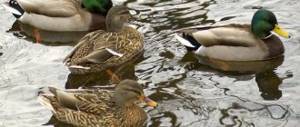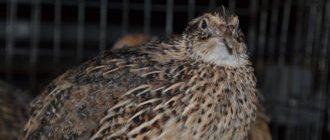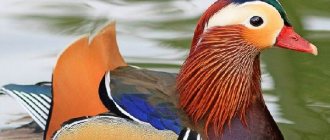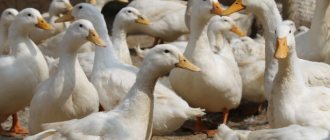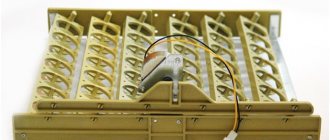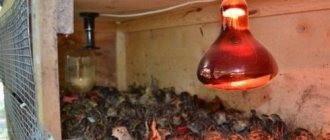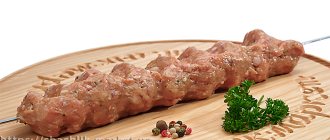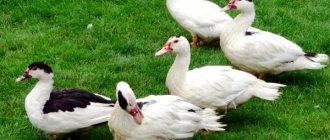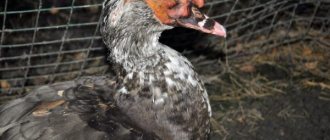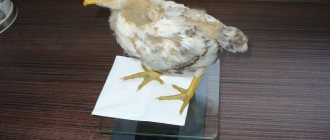What to feed at different times of the year?
in winter
For the first and second meals, it is advisable to feed the birds a wet mash, which includes pre-boiled grains, vegetables, cake, as well as mineral and protein supplements.
By evening, it is advisable to feed the ducks with grain feed. Since it is well absorbed and takes a long time to digest, the birds will sleep peacefully all night. Due to the feeling of hunger, birds sometimes begin to eat hay used as bedding.
In spring and summer
Provided that the ducks have to regularly be in the pen, and there is no opportunity to walk freely, it is recommended to feed them at least four times a day. The first two meals consist of the above-mentioned wet mash, the remaining ones consist of dry food and cereals. During the entire warm season, it is recommended to ensure that ducks have sufficient consumption of fresh root vegetables and greens.
What to feed little Achatina
The basic foods of the diet of small snails should be finely grated or chopped vegetables, herbs and fruits. It is useful to add vitamins to your diet. Little Achatina happily crunches on lettuce leaves and thinly sliced cucumber.
At the age of two weeks, snails are accustomed to carrots and apples. You should sprinkle all vegetables and herbs with crushed calcium, since Achatina actively grows and develops in the first months of its life.
In addition to plant foods and calcium supplements, the small snail needs protein food. Dried gammarus and daphnia are good protein supplements. These are common foods for aquarium fish that are sold in pet stores and at the poultry market. The food consists of dried freshwater crustaceans, which contain a large amount of nutrients, vitamins and microelements that are so necessary for the growing body of the snail. Read more in the article about Gammarus
See more similar articles:
Is it possible to give snails milk?
What grass can be given to Achatina and stored for the winter?
Back Forward 1 of 13
Starting from three weeks of age, you can introduce foods that are fed to adult Achatina. Now choose thinly sliced vegetables and fruits over grated foods. Peel vegetables and fruits from hard skins, so it will be easier for kids to get to the tasty and juicy center.
Starting from the age of one month, feed the snail all the vegetables and fruits in season. For example, Achatina loves beets - both leaves and turnips. It is advisable to wash the leaves thoroughly and chop them finely, and grate the beets and mix them with calcium supplement.
Young snails, just like adults, eat all kinds of vegetables, all kinds of greens, fruits, cereals, and herbs.
Little snails happily eat Chinese cabbage, crunch on zucchini and pumpkin, lettuce and Jerusalem artichoke, sweet pepper and peas. They love Achatina - sweet apples and peaches, bananas and pears, apricots and plums, strawberries and raspberries, melon and juicy watermelon.
What to feed on the first day of life at home?
The second question that a novice farmer faces after purchasing chicks is what to feed the little ducklings in the first days of life. The gastrointestinal tract of ducklings is different from that of adults, so food suitable for adult ducks will not be suitable for babies.
Ducklings have a higher degree of digestibility of food and a more intense metabolism compared, for example, with chickens.
Newborn ducklings need to be fed 4-5 times a day. Food in the first 2-4 days should be enriched with protein as much as possible; it helps ducklings grow. For these purposes, mash is prepared for children from chopped boiled eggs, cottage cheese with the addition of milk and any fermented milk products - kefir, yogurt, whey.
Food must be fresh, uneaten remains must be disposed of, preventing food spoilage.
Already in the first days after birth, greens are added to the birds' food. In summer, it is better to use fresh, finely chopped. If ducks are to be raised in the winter, a sufficient amount of greens should be dried in advance during the summer season to be added to the mash. Nettle, clover, alfalfa and even dandelion are used for these purposes.
It happens that small ducks initially refuse to start eating, as a result of which they may die. In such cases, a weak pink solution of potassium permanganate is forcibly infused into the duckling using a pipette, after which a crumbled boiled egg is offered.
Feeding week old ducklings
Next, any farmer faces a logical question: what and how to feed week-old ducklings? In addition to the high protein content, grain crops should be present in duck food from the first week. Their grain digestibility rate is about 80%, which is even higher than that of chickens.
In addition, the grain also contains protein, about 10-15%. In the first 7-10 days of life, birds are given mixed feed with the addition of cottage cheese, fermented milk products, finely chopped nettles and other greens. Fresh nettles must be scalded with boiling water before use. Greens contain a number of vitamins necessary for normal growth, development and strengthening of the immune system. Also, already in the first week it is necessary to enrich the food with minerals required by the rapidly growing body of the chick. It is possible to try giving the duckling Start food.
You may be interested in the following duck-related articles:
- Breeding and raising ducks at home.
- Incubation of duck eggs at home.
- How to raise mulard ducks at home?
For this purpose, chalk, fish or meat and bone meal, crushed shells or crushed eggshells are added to the food. Until the second week, mineral supplements are added at the rate of 1 gram. on the head.
Feeding two-week-old chicks
But what to feed ducklings at 2 weeks and how much food to give is a question that rarely arises. After all, from the second week, young animals can be released if there is a paddock with access to a reservoir. In this case, the chicks will receive part of their food in their natural environment. They will need to be fed only twice a day - morning and evening.
In the morning, two-week-old chicks are not fed enough, so that the babies can get enough on their own during a walk. When birds are in a confined space, the feeding load increases.
From the second week, it is advisable to add duckweed to the food, which ducks simply adore.
Cottage cheese and eggs are removed from the mash, replacing with boiled root vegetables, for example, potatoes, sugar beets, carrots. In winter, from the second week, ducks can be fed with combined silage. The main part of the feed at this stage is compound feed, a slightly smaller part is greens.
At this age, to improve digestion and stimulate intestinal function, farmers add a little sand or fine gravel to the feed.
Feeding grass to slightly grown ducklings
What do snails eat after birth?
Snails are born approximately three weeks after the eggs are laid in the ground. During the first days they eat the shells that are left after their appearance. Experts say that food in the form of shells is basic for newborns, so some sources say that for the first five days of a snail’s life, additional feeding may not be done at all.
However, young snails may well eat a leaf of greenery that has been previously sprinkled with sepia, shell or chalk. It is also quite possible to place grated fruits on lettuce leaves in a container with young animals, which should be sprinkled with fertilizer containing calcium, which is necessary for newborn snails. For a couple of days after their appearance, the babies will eat the food you offer and hide in the ground, while eating the remaining shells. You should also remember about the water that young individuals need.
Thanks to calcium, snails develop a shell of a regular and beautiful shape.
After 4-5 days after birth, the Achatina should be transplanted into a small, pre-prepared container, at the bottom of which lettuce leaves should be placed instead of the usual flooring. For the first seven days, the young move little, while eating a lot of food.
Little ulitos should be fed daily, offering them various foods, pre-grated or crushed:
- Suitable vegetables include cucumber, pumpkin, zucchini, cabbage, and carrots.
- Suitable fruits include pear, strawberry, apple, watermelon, melon.
- From greens you can give leaves of dandelion, lettuce, parsley, burdock, dill, nettle.
- Gammarus, daphnia, chalk, shell rock, and sepia can be given as a protein component.
Owners should know not only what to feed small snails, but also foods that are best not given to newborns, namely viscous food such as cereal and banana, since snails can suffocate in it.
Tips for feeding Mulard ducks
There are a number of recommendations given by breeders of Mulard ducks. In general, they are simple to perform, but can greatly simplify and reduce the cost of feeding, as well as keep the bird healthy and accelerate its growth.
One feeder in a poultry house is designed for no more than 12 ducks! Otherwise the birds will fight. The water is changed 2 times a day, as it quickly becomes dirty, and in the summer it is drunk. The drinking bowl is always made deep so that the birds can clean their beaks in it. Before feeding mulard ducks that have just hatched from the shell, you need to drip a weak solution of potassium permanganate into their beaks to disinfect
And in the future, you can repeat the procedure until the young animals get stronger. In the brooder and in the poultry house where mulards are kept, you need to install feeders with fine gravel, chalk, and crushed shells
When purchasing feed for ducks, it is important to clarify for whom it is being purchased. Since feed for cattle contains urea and other components that are harmful to birds
Heat, midges, and stuffiness lead to rapid souring of the food in the feeder in the summer, so it is worth feeding the birds in limited quantities; if there is not enough food in the feeder, they will be able to find additional food on the run
But eating spoiled food can negatively affect their health. Mulard ducks should be fed at home only from clean feeders. Therefore, you need to wash them immediately after the bird has eaten. This reduces the risk of food going sour and also protects the poultry house from midges. In addition to the products listed in the article. Mullards simply love quinoa seeds and millet. If you have such products, you can safely put them in the mash to increase the birds’ appetite. Various chemicals and expensive substances are not needed for feeding mulard ducks at home; they grow quickly without them. But vitamins won’t hurt and will have a positive effect on gaining muscle mass.
How to properly maintain
Experts in numerous videos claim that ducklings need warmth. When raising chicks at home, it is necessary to equip the poultry house with special equipment.
You can use some tricks:
- You can construct a wooden box by placing it on stands.
- The inside should be lined with foam plastic.
- Place a container filled with hot water in the drawer. Volume – 10 liters. The top of the box should be covered with a blanket or pillow to provide thermal insulation.
- A hole should be cut in the side wall through which the ducklings can get to the heating pad.
This design can retain heat for 8 hours. In the first 7 days of life of young chicks, a high temperature (28-30 degrees) should be maintained on the floor. After two weeks, the level must be reduced to 22 degrees. In three - up to 16.
As numerous videos show, the easiest time to care for little ducklings is in the spring months. For ducks, it is enough to fence off a space in the yard. The main thing is to ensure that the chicks are protected from drafts.
Wild ducklings are partial to water. Numerous videos serve as excellent proof of this. However, experts do not recommend allowing them near water bodies until they are 20 days old. If the chicks start swimming in cold water, they may catch a cold. Therefore, it is enough to place a container of water in the duck house.
What food can be used when feeding small chicks?
The most suitable starter feed for ducklings in the first twenty days of life is PK-21. Combined food for this age group of waterfowl best meets the needs of the body at this stage.
Since the food of waterfowl in the natural environment is predominantly wet, for ducklings kept at home it is advisable to additionally moisten the feed with milk, whey or meat broth. This mixture is classified as perishable, therefore, in cases where the chicks have not consumed all the food, the feeders need to be cleaned of residues. It is recommended to switch one-month-old ducklings to the combined feed PK-22.
Composition of feed PK-21:
| Recipe Ingredients | % |
| Wheat | 33,54 |
| Corn | 25 |
| Soya extruded | 2 |
| Bran | 5 |
| Soybean cake | 12 |
| Sunflower cake | 17 |
| Chalk | 2,4 |
| Fish flour | 0,5 |
| Monocalcium phosphate | 0,85 |
| Table salt. | 0,3 |
| Lysine | 0,27 |
| Methionine | 0,14 |
| Premix (enzyme) | 1 |
| 100 |
| Guaranteed performance | % |
| Humidity | 12,5 |
| Crude fiber | 6 |
| Crude protein | 18,5 |
| Crude fat | 6,26 |
| Metabolic energy, kcal | 282 |
| Methionine+cystine | 0,77 |
| Methionine | 0,47 |
| Lysine | 1 |
| Threonine | 0,63 |
| Calcium | 1,1 |
| General phosphorus | 0,7 |
| Sodium | 0,16 |
Composition of feed PK-22:
| Recipe Ingredients | % |
| Wheat | 53,817 |
| Corn | 15 |
| Sunflower cake | 19,5 |
| Soybean cake | 2 |
| Soya extruded | 4,8 |
| Monocalcium phosphate | 0,9 |
| Chalk | 2,4 |
| Table salt. | 0,28 |
| Lysine | 0,27 |
| Methionine | 0,033 |
| Premix | 1 |
| 100 |
| Guaranteed performance | % |
| Humidity | 12,5 |
| Crude fiber | 5,8 |
| Crude protein | 16,8 |
| Crude fat | 5,6 |
| Metabolic energy, kcal | 295 |
| Methionine+cystine | 0,68 |
| Methionine | 0,35 |
| Lysine | 0,87 |
| Threonine | 0,57 |
| Calcium | 1,1 |
| General phosphorus | 0,65 |
| Sodium | 0,18 |
Feeder for proper nutrition of grown ducks
Do-it-yourself starter feed for one-month-old ducklings
A couple of ways to prepare combined feeds for young animals over one month old on your own. Method one. To prepare you will need to mix:
- 45% corn;
- 17% sunflower cake;
- 13% wheat;
- 8% barley;
- 5% feed yeast;
- 4% fishmeal;
- 3% feed fat;
- 1% meat and bone meal;
- 1% grass meal and chalk.
Another recipe for making it yourself:
- 51% corn;
- 19% wheat bran;
- 19% cake (soybean or sunflower);
- 4% wheat;
- 2.4% feed fat;
- 1.7% defluorinated phosphate (tricalcium phosphate);
- 1.5% shell (or eggshell);
- 1% feed yeast;
- 0.4% salt.
Choosing ducklings
You need to buy chicks in early spring - at this time the best prices for birds are. The meat will be ready by mid-April, when prices for duck are still very high, which significantly increases the profitability of duck farming.
When choosing ducklings, you should pay attention to the following points:
- Place of purchase. It is better to use the services of an incubator, where there are documents for the birds and certificates for activities - the price is 5-10% higher, but there are at least some guarantees.
- Mobility and activity of the bird. Choose the noisiest and most active individuals that have shiny fluff (indicates good vitaminization of the body) and dry butts.
- A good appetite. If you take chicks, give them food, they should eat it with appetite. And this does not depend on whether they have eaten or not before. Literally 5 minutes after eating, the baby will peck food again if he is healthy.
The offspring must be transported in a homemade box - a cardboard box with holes on all sides for ventilation. Chicks are afraid of high temperatures and can suffocate if there is a lack of oxygen. If you drive for a long time, you can stop once for 1 hour and open the box so that the ducklings can breathe some air outside.
Consequences of an unbalanced diet
Ducks are most vulnerable when they are three weeks old. If at this time pets lack mineral elements, they may develop weakness in the legs. This happens due to a violation of the ratio of phosphorus and calcium in the proposed feed. Birds may also be susceptible to the following diseases:
- Vitamin deficiency A. Accompanied by loss of appetite, conjunctivitis and severe depression. It is treated by adding fish oil and vitamin A to food, diluted in clean water (it should not be cold). Green herb flour should be added to the feed.
- Vitamin deficiency E. Lethargy, weak pulse, convulsions, lack of appetite are the main symptoms of the disease. It can be treated by adding drops of tocopherol to food (you should consult your veterinarian first). To prevent disease, feed birds with hay flour, wheat, and dairy waste.
- Urovsky disease. If the food is not enriched with sulfur-containing amino acids, the chicks will lose feathers, begin to pluck each other and eat the ground. Dilute the diet with iodized salt, crushed chalk and bone meal.
- Cuticulitis. Accompanied by diarrhea, which contains undigested food debris. Balance your diet, add vitamin A and nicotinic acid to the food, and a drop of potassium permanganate to the water.
Chicks up to 1 month old suffer from cuticulitis.
Video - How to properly raise a healthy duckling?
Feeding newborns and growing chicks is not a difficult task. Any novice farmer can raise healthy poultry and obtain high-quality meat products. Provide growing ducklings with good living conditions and healthy food that will contain all the useful vitamins and minerals. Only in this case will the ducklings be healthy and gain the required weight in a short time.
Features of breeding and raising ducklings at home for beginners
Having received offspring from eggs or purchased day-old ducklings, you should figure out how to support them. The main requirement is to provide heat. If the chicks are kept in a box or basin, then bedding should be made on the floor (you can put a piece of cloth or a disposable diaper). An incandescent lamp is hung on top so that the young animals cannot reach it. If the ducklings are cold, they will huddle under the light bulb.
Ducklings in a brooder
Prices for a ready-made brooder for chickens
Chick brooder
In the first 5 days it is necessary to maintain the temperature at 26-28°C, from 6 to 11 days 22-26°C is sufficient, and by day 20 it can be reduced to 18°C. Month-old birds can live at a temperature of 16°C.
Starting from two weeks of age, ducklings can be bathed. They are not immediately released into open reservoirs; they are given a container with heated water in which they will swim. But during long swims, the chicks can become hypothermic and get wet. Therefore, farmers carefully monitor bathing times.
Features of keeping young ducks
But you shouldn’t worry about the kids who are with the hen. The duck itself provides them with the necessary heating and takes them for a swim from the 3rd day of life. The hen lubricates her charges with fat, which prevents them from getting wet. But it is advisable for the poultry farmer to ensure that the newly hatched babies are in the water for no more than half an hour.
Video - How to raise healthy ducklings
Poultry farmers must know the peculiarities of raising poultry on free land and water range.
Expert advice
By adhering to the following feeding standards for ducklings, you can simplify the process of raising poultry and increase the survival rate of young animals.
The water in the drinking bowl should always be clean and fresh
- Any new foods or cereals should be introduced gradually. You cannot introduce all foods into your diet at once - this can be very harmful. So they give new ingredients one at a time and watch the reaction. If the birds do not have diarrhea, constipation or any other problems after the new food, you can continue to feed them this product.
- Any food should be fresh, just like water. Otherwise, the birds may develop diarrhea, and over time, without treatment, they will die.
- Feeding ducklings is possible only with crumbly food throughout their life. If the food is viscous, sticky or liquid, it will be difficult to eat. So this point must be strictly controlled before each serving of food.
- Feeders for mash, dry food and water should be washed 1-3 times a day. Before each new serving of food, they should at least be rinsed under a strong stream of water and doused with boiling water.
- Any purchased vitamins can be given only after they are recommended or prescribed by a veterinarian. Buying vitamins blindly, without knowing all their side effects or actions, is not worth it, it is at least dangerous.
We invite you to familiarize yourself with Feeding sheep producers: useful tips
Nutrition for two-week-old ducklings
At the age of 10-14 days, mixed feed is introduced into the diet. They are included in the national OKPD system, which indicates the safety of the products. First they give the starting lineup. Duckling food is sold in specialized stores. If desired, you can do it yourself at home. It consists of grain crops, soybean cake or sunflower meal, eggs or cottage cheese, feed yeast, and chopped grass. To raise healthy birds, mineral supplements are included.
Depending on the grains and mineral supplements used, the value of the feed varies. Wheat-based formulations are popular. Recipes:
- To prepare the daily requirement (200 g) you will need: 94 g of wheat, 30 g of barley, 20 g of corn, 18 g of sunflower meal, 14 g of feed yeast, 2 g of chalk and shell rock, 0.1 g of table salt.
- More fortified feed for two-week-old ducks is prepared from 98 g of wheat, 3 g of barley, 20 g of corn, 14 g of sunflower meal, 14 g of fish meal, 8 g of feed yeast, 8 g of grass meal, 2.8 g of chalk or shell rock (or 1.4 g of each mineral supplement), 0.2 g of table salt.
One-week-old chicks can also be fed with this feed, after adding low-fat cottage cheese and chopped eggs. However, at this age the body is not always ready for such compounds, which is why complementary foods are introduced carefully. If diarrhea or other gastrointestinal disorders occur, complementary foods are removed from the diet before reaching two weeks of age.
The feed is not brewed, otherwise it becomes sticky. And this is fraught with gluing of the beak and blockage of the esophagus. Based on the mixtures, mashes are prepared by adding low-fat kefir. The mash should be crumbly.
Small ducks that have reached the age of 14 days are fed 5-6 times. This feeding system is followed until the birds reach one month of age.
Do ducklings need feed?
Also check out these articles
- Planting grapes in autumn
- Application of remotely controlled pipeline fittings in agriculture
- Shire horse
- Raising broiler turkeys
Compound feed is the best food for ducklings. In poultry farms, it is the only thing used to feed birds, but it is very expensive, so at home it is not profitable to use compound feed for daily feeding of ducklings. If it is used, it is only in a mixture with other homemade feeds, or they simply make homemade feed.
Compound feed is the best food for ducklings
If you want to feed ducklings with compound feed from the first days of life, but buying it is too expensive, you can make it yourself. To do this you need to mix:
- 10 g chopped eggs;
- 13 g wheat and corn flour;
- 2 g milk powder;
- 3 g fresh cottage cheese;
- 1 g meat and bone meal;
- 1 g fish meal.
All indicators are for 1 bird. This compound feed is prepared right before feeding the ducklings. The reason is that this mixture turns sour very quickly, becomes moldy and can no longer be given. They feed it to the birds in such quantities that they eat everything. The remains are immediately removed for the same reason that feed is not stored for future use.
This feed is suitable for young animals from 1 to 10 days. A little later, it is still recommended to purchase simple “Start” type feed, but do not give it pure, but dilute it with crushed grains of wheat, barley and corn in proportions of 1:3. This will save significant money.
Fattening ducklings for meat
Ducklings are usually not susceptible to diseases that can harm other birds, so there is no need to use various veterinary drugs to accelerate growth and development. Do not give your ducklings chemicals: if the medicine is used incorrectly, it can cause harm to your pets. Allow individuals to plant food at the end of spring, let them walk outside and eat in nature. If the weather is bad and there is no opportunity for walking, cut off the vegetation and bring it to the house.
Plant food for fattening ducklings for meat
In winter, it is necessary to dilute the diet with nutritious feed. To feed one chick during the cold period, you will need potatoes (13 kg), root vegetables (10 kg), hay (8 kg), bedding (12 kg), medium-sized granular sand (600 g), as well as combined food (1 kg) or other mineral food. If you feed the offspring correctly and provide them with proper maintenance, the individual will reach the weight required for slaughter by nine weeks. For example: after consuming 10 kilograms of feed, a Peking duck weighs three kilograms, and Muscovy ducklings will have to be fattened a little longer.
What are the benefits of homemade mash for ducklings?
In addition to feed and grain, ducklings need wet mash for normal life. Feeding ducklings with them is carried out approximately 2 times a day. Usually this time falls in the morning and second lunch.
In addition to feed and grain, ducklings need wet mash for normal life.
They are made from various root vegetables and vegetables. Carrots, cabbage leaves, pumpkin, beets, rutabaga are taken fresh, grated on a fine grater, and potatoes, if given, are only boiled and mashed. The mash is fed immediately after preparation. You can’t make them for future use, as they are wet and will turn sour very quickly, especially in the summer.
It is worth noting that feeding mash is very important if ducklings are fattened for meat, since such food contains an abundance of nutrients that are very necessary for this bird
What vitamins can be given to ducklings?
We recommend reading our other articles
- Raspberry variety Pshehiba
- Common diseases of turkey poults and their treatment
- Wheat gluten
- Description of the Rinda cabbage variety, planting and care in open ground
For normal life and development, ducklings need vitamins. From ordinary foods rich in vitamins, you should give fishmeal, which can be used to cook broth for mash or simply add to food. Meat and bone meal is no less beneficial.
Vegetables rich in vitamins for ducklings
Vegetables (carrots, pumpkin, sugar beets, rutabaga, potatoes) are also rich in vitamins. They are always given in mash, but the products must be fresh. It is worth noting that feeding ducklings vegetables at home involves chopping the pulp rather than peeling or peeling them. Because the pulp contains everything that birds need.
Chalk and crushed shells play an important role in the normal digestion of ducklings. They can be mixed into food from the 5th day of life, mixed into food. But, in addition, in the duckling house there should be a separate bowl or feeder, where shells and chalk will be poured in abundance. If the bird needs it, it will start eating them itself.
Features and norms of nutrition
Before creating a diet for your pets, decide for what purpose you are getting them and how quickly you need to fatten the ducklings. Be sure to take into account the characteristics of the breed: for example, birds born in production do not get used to homemade food well and need special factory feeding. In other cases, the duckling menu will not be different. When feeding, follow these guidelines and tips:
- feed ducklings several times a day - newborns up to eight times, two-week-olds - from four to five;
- before switching to food, feed weak chicks with beaten yolk;
- ensure that birds have constant access to food and water;
- 16 weeks after birth, ducklings are ready to switch to adult food;
- medicinal feeds for healthy ducklings are contraindicated - they can damage the internal organs of newborns;
- When buying food at a pet store, give preference to food specifically for ducklings - food for chickens is not suitable;
- Do not feed your pets food that is not intended for them - for example, do not give bread or bread crumbs.
Keeping and feeding ducklings in production
| Type of feed (grams per day) | The age of the cubs is from 1 to 10 days | Age from 11 to 20 days | Age from 21 to 30 days |
| Combined feed | 25 | 70 | 110 |
| Green vegetation in summer | 15 | 60 | 90 |
| Combined silage in winter | No | 10 | 20 |
| Food waste | No | 15 | 40 |
| Needles | 0,3 | 1 | 2 |
| Small boiled potatoes | No | 10 | 15 |
| Return | 5 | 10 | No |
| Cottage cheese | 3 | No | No |
| Eggs | 3 | No | No |
| Duckweed | 10 | 15 | 5 |
| Fish or meat and bone meal | 0,5 | 1,5 | 3 |
| Feed yeast | 0,2 | 0,5 | 0,8 |
| Dry nettle (in winter) | 0,5 | 1 | 3 |
| Shells | 0,5 | 1,5 | 3 |
| Gravel | No | 0,5 | 1 |
| Chalk | 0,1 | 0,3 | 0,5 |
Feeding ducklings in the first two weeks of life
In the first few days, pets should be given a combination food. It is enriched with all necessary mineral elements and vitamins. Chalk, sand and crushed shells are poured into a separate feeder. On a home farm, ducklings are often fed boiled chicken eggs. From the third day, babies actively get accustomed to grass. To make them better absorb vegetation, chop it with a grass cutter or use a regular knife. The amount of green food should not exceed 15% of the total diet. Monitor your birds closely to ensure they do not have diarrhea.
Shredded green feed for ducklings
Prices for popular models of grain crushers, feed cutters and grass cutters
Grain crusher-feed cutter-grass cutter
Feeding ducklings after two weeks of life
Starting from the second week, you can give your pets a mash, which contains crushed wheat, barley, as well as bran, fish or meat and bone meal. Preference should be given to the wet version - this mash is more crumbly, it does not stick together and does not seal the nasal openings. You can make the mixture using yogurt or whey. Give this mixture during the day, and add the combined food at night. Between feedings, treat your pets to fresh grass, chopped fruits and vegetables. Birds can also peck weeds from the garden.
Ducklings can also eat garden weeds
Make sure that wet mash is eaten by birds at once - it may spoil. If feeding dry food, feed it in excess and make sure there is always food in the food dish. Don't forget about mineral supplements - ground shell, sand and gravel. Thanks to this diet, birds grow faster. At the age of 55 days, pets gain weight of 2 kilograms, it is at this time that the bird can begin to be slaughtered.
Table of nutritional norms by period: daily and weekly ducklings
Depending on age, they create a menu for waterfowl. All detailed information about the number of products is provided in the tables.
Depending on age, they create a menu for waterfowl
Experienced farmers give an example of a properly selected diet for ducklings.
Table 1 (calculation per 1 individual):
| Products | Number of grams depending on the age of the bird | |
| 24 hours | 7 days | |
| Boiled egg | 40-60 | 120 |
| Dill | 10 | 14 |
| Cottage cheese | 3-4 | 5 |
| Barley chaff | 16 | 35 |
| Corn porridge | — | 25 |
| Millet cereal | — | 10 |
| Fish fat | — | 5 |
| Bone flour | — | 5 |
| Fish flour | — | 10 |
Table 2 (calculation for 1 individual, with the addition of starter feed):
| Products | Number of grams depending on the age of the bird | |
| 24 hours | 7 days | |
| Boiled egg | 16 | 80 |
| Dill | 5 | 13 |
| Cottage cheese | 3-4 | 30 |
| Fish flour | — | 5 |
| Nettle (dry) | — | 17 |
| Yeast (specialized for birds) | — | 2 |
| Eggshell | — | 4 |
| Chalk | — | 5 |
| Starter feed | 17 | 50-80 |
Be sure to read:
Everything you need to know about the diet and feeding of domestic ducks: experience and advice from experienced poultry farmers
Consequences of poor feeding
Feeding ducklings at home is not a difficult science, but you can’t do it without practice. Beginning breeders should raise ducklings at least once in order to understand what and in what quantity they need in a given case. All tables and standards are always adjusted depending on the breed, characteristics of the bird and living conditions, so it is difficult to give exact figures. There is no way around this without negative experience. Below are the consequences that you may face if you eat incorrectly.
All tables and nutrition standards for ducklings are always adjusted
- Newborns up to 2 weeks of age react very sharply to any new products in the diet and the quality of food. Spoiled foods or some unusual ingredients can cause gastrointestinal problems, diarrhea, and then death. The problem is that breeders feed all the ducklings at once, which means that the entire livestock can die from simple feeding.
- From 3 weeks, ducklings become most vulnerable. Due to lack of food or nutrients, they may develop weakness in their legs.
- Also, if there is a lack of amino acids at 3 weeks of age, the feather growth process will be disrupted, the birds will begin to pluck themselves, and the quality of the feathers will be very low. This will lead to the fact that the grown ducklings will have bald patches. Because of this, they may be cold, it will be difficult for them to swim, and they may not survive the winter without heating in the house.
- A lack of vitamins in food can lead to disruption of the development of organs and systems, as well as lead to slow growth.
Diet planning
The nutrition of ducklings is different in that from the first days the components are introduced alternately. Their share is increasing gradually. Also, compound feed is added to the diet of fattened birds, which promotes weight gain and serves as a vitamin supplement.
For newborn ducklings
The hatched chicks are given water through a pipette or by dipping their beaks into a drinking bowl. After two hours, you can give the first food - finely chopped boiled eggs of any poultry. Immediately after hatching, they do not experience hunger, but in the first 24 hours they need to be fed frequently - every 2 hours.
Expert opinion
Zarechny Maxim Valerievich
Agronomist with 12 years of experience. Our best country expert.
Ask a Question
From the first days of life, ducklings are given animal products - low-fat cottage cheese or milk, to which eggs are added. For newborn ducklings, their first food is laid out on the bedding and then placed in feeders.
After three to four meals, small ducklings are given a pale solution of manganese to drink to prevent indigestion and the development of gastric infections. When raising ducklings for fattening, feed is added to the curd-egg mixture from the first day for growth.
For daily allowance
The diet of ducklings from two days of age includes:
- herbs or soybean meal;
- corn grits;
- flour from meat and fish waste;
- chalk;
- shells.
The components are mixed in broth or yogurt. When feeding ducklings at home, it is important to immediately remove uneaten mash. In milk mixtures, fermentation begins, which is harmful to digestion.
For weekly
On the seventh day, the ducklings are ready to walk around the pasture and can get green food on their own.
Composition of the diet of 10-day-old chicks:
| Name | Quantity of the total mass (in percentages) |
| Corn | 50 |
| Sunflower cake | 20 |
| Broken wheat | 13 |
| Fish flour | 7 |
| Feed yeast | 5 |
| Chalk | 0,5 |
The food consumption rate for one duckling is 80 grams per day with a weight of 500 grams. During the growth period, fish oil is used as a vitamin supplement to meet the need for Omega-3 fatty acids. Ducklings need to be carefully looked after: watered with potassium permanganate once a week, protected from drafts and overheating.
Two weeks
2 weeks after hatching, ducklings stop being given eggs. Boiled vegetables are included in the diet. They are added to wet mixtures along with cracked corn, bone meal and plants. Chicks begin to swim during this period, so they need special care. When walking or indoors, bowls of water are placed for them to bathe. In nature, ducklings follow ducks to a pond and learn to catch fry and insects. You can also introduce small fish and bloodworms into improvised reservoirs. The ideal option is an artificial pond in the garden.
Three weeks
The diet does not change significantly in the 3rd week. Ducklings eat moist mash with greens, grain husks, vegetables and corn. When grazing, grass is not added to the feed. Preference should be given to walking in an area with alfalfa and clover.
Menstruation
Grown chicks are fed 3-4 times a day. Their diet is close to that of adult ducks:
| Name | Daily norm per individual (in grams) |
| Barley | 15-50 |
| Wheat | 20-30 |
| Corn | 40-70 |
| Hulled millet | 8-19 |
| Meat and bone meal | 5-6 |
| Fish fat | 0,1-1 |
| Fish flour | 9-12 |
| Chalk, shells | 1-5 |
| Yeast | 4-6 |
In addition to chalk and shells, fine gravel, which is also served in a separate bowl, promotes good digestion.
After a month
Older ducklings are fed like adult birds - 3 times a day. 60 percent of the diet consists of cereals, 30 percent is succulent food. Corn, crushed barley and wheat are not added to the mash, but are given in separate feeders. Wet food consists of dairy products, vegetables, and bran.
Differences in maintenance (care with and without a pond)
Ideally, ducks should have access to water. A pond or small river with a weak current and grass along the bank will do. In this case, there will be virtually no need for additional feeding with vitamins and minerals, since the ducks will receive the necessary dietary supplements from a natural environmental source. In addition, the presence of a reservoir can significantly reduce feed costs.
Of course, in severe winter conditions, when water bodies are covered with ice, birds are not able to get food for themselves. Therefore, the cost of maintaining ducklings in winter will be higher, even taking into account the presence of a reservoir. Unfortunately, not always and not every yard has a nearby pond, stream or river.
The fact of the absence of a reservoir must be taken into account when feeding, artificially enriching the food with the necessary additives.
On the 70th day of life, a male duck begins to molt, therefore, for the convenience of cutting the carcass, it is recommended to slaughter him before the molting period. And the drake meat, after it reaches the age of 2.5 months, has nowhere to put it, as it becomes tough. This must be done so that later it will be easy to pluck the carcass.
There are several plucking processes. But in order to successfully sell duck meat, you should know the nuances of each method. The first method is called hot. It is ideal for those who are going to immediately prepare a poultry dish and eat it. The fact is that with this method of plucking, due to the high temperature of exposure to the feather, skin and meat may change color slightly.
